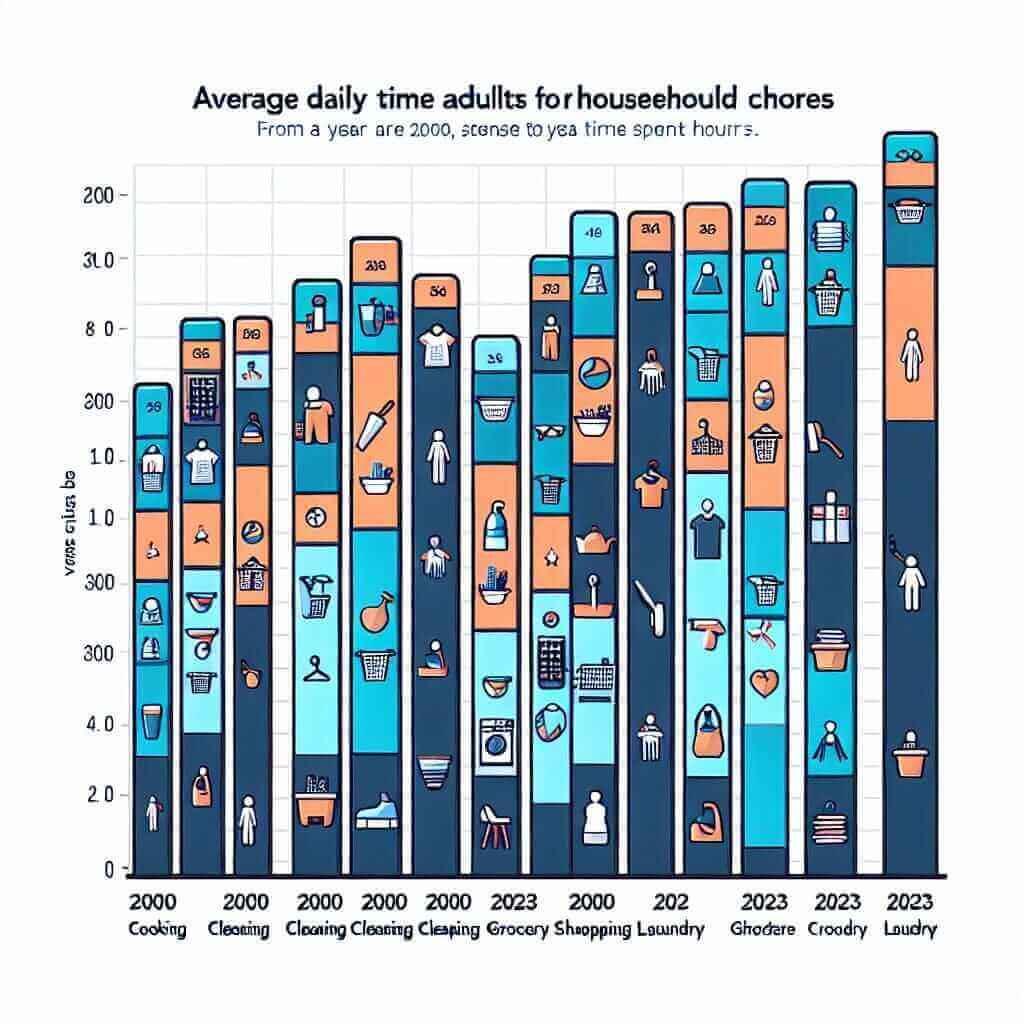In this article, we will delve into the topic “Average Daily Time Spent on Household Chores (2000-2023),” a frequent theme in IELTS Writing Task 1. We’ll create a model task, analyze it, and provide a detailed sample answer. This guide ensures you grasp the necessary tactics, vocabulary, and grammar to achieve a high band score.
Task Overview
The topic “Average Daily Time Spent on Household Chores (2000-2023)” often appears in IELTS Writing Task 1. Candidates are required to interpret data from various charts and graphs. Here’s a possible task:
The bar chart below shows the average daily time spent on household chores by adults in one country from 2000 to 2023. Summarize the information by selecting and reporting the main features, and make comparisons where relevant.
Below we’ve created a sample bar chart based on this topic.

Analyzing the Task
1. Identify key information
- Title: Average Daily Time Spent on Household Chores
- Time Frame: 2000 to 2023
- Main Variables: Different Types of Chores
2. Organize the Information
- Determine main trends: Increase or decrease over time.
- Compare different categories: Which chores took more time historically versus recent years.
Writing the Sample Task
Sample Task Answer
The bar chart illustrates the average daily time spent on various household chores by adults in a specific country between 2000 and 2023.
Overall, it is observed that the total time invested in household chores has generally increased over the period, with particular activities like cooking and cleaning occupying a larger portion of daily schedules. Conversely, time allocated to childcare has shown a slight decline.
In 2000, adults spent an average of 60 minutes per day on cooking, which rose steadily to 80 minutes by 2023. Cleaning also observed a notable increase from 45 minutes in 2000 to 70 minutes in 2023. Meanwhile, the time devoted to grocery shopping remained relatively constant, with a minor rise from 30 to 35 minutes.
Interestingly, time spent on childcare slightly decreased from 40 minutes per day in 2000 to 35 minutes in 2023. This trend could be attributed to shifting societal norms and the increased dependence on childcare services.
Moreover, other activities, such as laundry, saw a moderate increase from 20 to 30 minutes over the years. This indicates a general trend towards more time being dedicated to maintaining household hygiene and cleanliness.
In conclusion, while some chores have seen a consistent increase in the time spent, others like childcare have slightly diminished, reflecting changing societal values and lifestyles.
Word count: 220 words
Key Considerations for Writing
Vocabulary and Phrases
- Trends and Comparisons:
- Increase, rise, growth, escalate
- Decrease, decline, drop, reduction
- Steady, consistent, notable, slight
- Time Identification:
- In 2000, by 2023, over the period, during the years, from 2000 to 2023
- Types of Chores:
- Cooking, cleaning, childcare, grocery shopping, laundry
Grammar Tips
- Use a variety of verb tenses to describe changes over time (e.g., past simple, present perfect).
- Make comparisons using comparatives and superlatives (e.g., more than, less than, the highest, the lowest).
- Use appropriate transitions and linking words to ensure coherence (e.g., meanwhile, furthermore, interestingly).
Important Vocabulary
- Escalate (verb) /’ɛskəleɪt/: to increase or become higher.
- Decline (noun/verb) /dɪˈklaɪn/: a gradual decrease.
- Notable (adjective) /ˈnoʊ.t̬ə.bəl/: significant and worth noting.
- Consistent (adjective) /kənˈsɪs.tənt/: showing steady levels or patterns.
- Trend (noun) /trɛnd/: a general direction in which something is developing or changing.
Conclusion
To achieve a Band 7+ in IELTS Writing Task 1, a structured approach is essential: accurately identifying key trends, effectively comparing data points, and using suitable vocabulary and grammar structures. By focusing on these aspects, especially when dealing with workplace-related topics like the “Average Daily Time Spent on Household Chores (2000-2023),” you will be well-prepared to tackle varied task types in the exam.